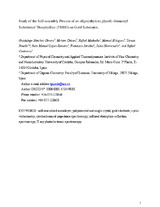Study of the Self-assembly Process of an oligo(ethylene glycol)-thioacetyl Substituted Theophylline (THEO) on Gold Substrates.
Autor
Sánchez-Obrero, Guadalupe
Chávez, Miriam
Madueño, Rafael
Blázquez, Manuel
Pineda, Teresa
López-Romero, Juan Manuel
Sarabia, Francisco
Hierrezuelo, Jesús
Contreras, Rafael
Editor
ElsevierFecha
2018Materia
Self-assembled monolayerPolyoriented and single crystal gold electrode
Cyclic voltammetry
Electrochemical impedance spectroscopy
Infrared absorption-reflection spectroscopy
X-ray photoelectronic spectroscopy
METS:
Mostrar el registro METSPREMIS:
Mostrar el registro PREMISMetadatos
Mostrar el registro completo del ítemResumen
A new oligo(ethylene glycol)-thioacetyl substituted theophylline (THEO) has been synthesized and used to form self-assembled monolayers (SAMs) on different gold substrates. The THEO-SAMs formed are compact and passivate the gold surface in an important extension. The thioacetyl group can be deprotected to release the mercapto-derivative that gives place to Au-S bond either in the absence or in the presence of base. Evidences that the THEO molecules bind to gold as thiolates are given by the behavior of the reductive desorption process of the SAM as a function of solution pH. However, some of the molecules can suffer breakage in the C-S position releasing thioacetic acid and the fragment oligo(ethylene glycol)-theophylline that can't bind to gold. The thioacetic acid generated at the gold surface can be catalytically decomposed to acetyl and atomic sulfur. The later can be bound to gold as it has been demonstrated by electrochemical as well as by XPS techniques. The resulting THEO-SAM has been structurally characterized by IRRAS. Comparison of the IRRAS with the spectrum of the bulk molecules allows us to conclude about some degree of organization of the THEO chains upon SAM formation. The results of this study can be translated to a gold nanomaterial conjugate to be assayed in studies of theophylline derivatives drug delivery in living systems.

